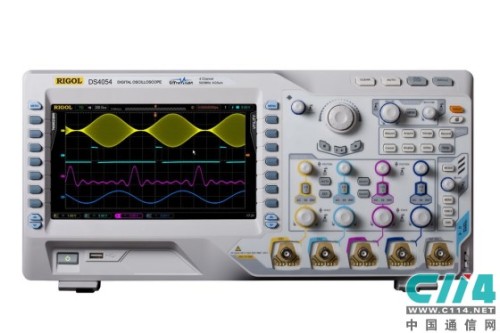RIGOL Pushes DS4000 Series Digital Oscilloscope Real-time Sample Rate Up to 4GSa/s
 RIGOL recently released DS4000 series digital oscilloscopes. The DS4000 series is configured with four levels of bandwidth of 500MHz/350MHz/200MHz/100MHz, and the real-time sampling rate is up to 4GSa/s.
RIGOL recently released DS4000 series digital oscilloscopes. The DS4000 series is configured with four levels of bandwidth of 500MHz/350MHz/200MHz/100MHz, and the real-time sampling rate is up to 4GSa/s. According to the person in charge of RIGOL, DS4000 series digital oscilloscopes use RIGOL's original UltraVision technology to achieve deep memory, high waveform capture rate, real-time waveform recording and playback, multi-level grayscale display and other functions.
It is worth mentioning that the DS4000 series is configured with 500MHz/350MHz/200MHz/100MHz four-level bandwidth, real-time sampling rate up to 4GSa/s, providing 2 channels and 4 channels respectively, a total of 8 models, standard storage depth of 140Mpts, waveform capture Up to 110,000 waveforms per second, hardware real-time waveform continuous recording and waveform analysis supports recording up to 200,000 waveforms and up to 256 levels of grayscale display.
At the same time, DS4000 has a wealth of trigger and bus decoding capabilities, including edge trigger, pulse width trigger, slope trigger, video trigger, pattern trigger, RS232/UART trigger, I2C trigger, SPI trigger, USB trigger, CAN trigger and FlexRay trigger, And supports a variety of serial bus triggering and decoding.
In addition, the DS4000 Series features low noise floor with a minimum vertical scale of 1 mV/div. In terms of product appearance, the DS4000 adopts an asymmetrical design concept and uses a 9-inch WVGA 256-level grayscale display to facilitate observation of various waveforms.
The responsible person stated that RIGOL DS4000 series digital oscilloscopes can meet the common design, debugging and testing of communications, semiconductors, computers, aerospace and defense, instrumentation, industrial electronics, consumer electronics, automotive electronics, field maintenance, R&D/education and many other fields. Demand.
Plate heat exchangers can be divided into categories according to their function or characteristics. The most common type is the Plate And Frame Heat Exchanger, which uses gaskets between its plates to create a hermetic seal between them. Another type is the Brazed Plate Heat Exchanger, which is a sealed unit where the plates are joined together by a brazing process. There are also welded plate heat exchangers, involving the use of welding, as well as semi-welded and fully-welded models. Pillow Plate Heat Exchanger consists of two thin metal plates with a herringbone structure on them, the plates are welded together to form a series of interconnected pillow chambers.
Plate heat exchangers are typically used for applications including heating, cooling, heat recovery and condensing, and are especially useful for industrial applications as they are compact. efficient, cost-effective, easy to use and require minima maintenance. Additionally, plate heat exchangers can be used totransfer fluids of different temperatures quickly and in a wide range of flow rates.
Plate heat exchangers are highly suitable for industrial and domestic applications such as air conditioning and refrigeration, radiators and condensers. Oil cooling, chemical processes, food and beverage processing.
Plate Heat Exchanger,Frame Heat Exchanger,Micro Plate Heat Exchangers,All Welded Plate Heat Exchanger
Guangdong Jiema Energy Saving Technology Co.,Ltd , https://www.jiemaheatexchanger.com